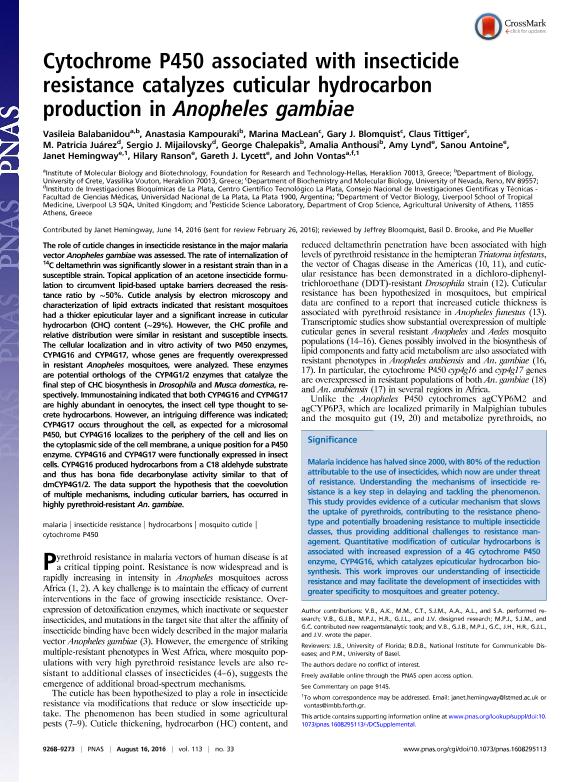Mostrar el registro sencillo del ítem
dc.contributor.author
Balabanidou, Vasileia
dc.contributor.author
Kampouraki, Anastasia
dc.contributor.author
Mac Lean, Marina
dc.contributor.author
Blomquist, Gary J.
dc.contributor.author
Tittiger, Claus
dc.contributor.author
Juarez, Marta Patricia

dc.contributor.author
Mijailovsky, Sergio Javier

dc.contributor.author
Chalepakis, George
dc.contributor.author
Anthousi, Amalia
dc.contributor.author
Lynd, Amy
dc.contributor.author
Antoine, Sanou
dc.contributor.author
Hemingway, Janet
dc.contributor.author
Ranson, Hilary
dc.contributor.author
Lycett, Gareth J.
dc.contributor.author
Vontas, John
dc.date.available
2018-06-15T14:58:41Z
dc.date.issued
2016-07
dc.identifier.citation
Balabanidou, Vasileia ; Kampouraki, Anastasia; Mac Lean, Marina; Blomquist, Gary J. ; Tittiger, Claus; et al.; Cytochrome P450associated with insecticide resistance catalyzes cuticular hydrocarbon production in Anopheles gambiae.; National Academy of Sciences; Proceedings of the National Academy of Sciences of The United States of America; 113; 33; 7-2016; 9268-9273
dc.identifier.issn
0027-8424
dc.identifier.uri
http://hdl.handle.net/11336/48776
dc.description.abstract
The role of cuticle changes in insecticide resistance in the major malaria vector Anopheles gambiae was assessed. The rate of internalization of 14C deltamethrin was significantly slower in a resistant strain than in a susceptible strain. Topical application of an acetone insecticide formulation to circumvent lipid-based uptake barriers decreased the resistance ratio by ∼50%. Cuticle analysis by electron microscopy and characterization of lipid extracts indicated that resistant mosquitoes had a thicker epicuticular layer and a significant increase in cuticular hydrocarbon (CHC) content (∼29%). However, the CHC profile and relative distribution were similar in resistant and susceptible insects. The cellular localization and in vitro activity of two P450 enzymes, CYP4G16 and CYP4G17, whose genes are frequently overexpressed in resistant Anopheles mosquitoes, were analyzed. These enzymes are potential orthologs of the CYP4G1/2 enzymes that catalyze the final step of CHC biosynthesis in Drosophila and Musca domestica, respectively. Immunostaining indicated that both CYP4G16 and CYP4G17 are highly abundant in oenocytes, the insect cell type thought to secrete hydrocarbons. However, an intriguing difference was indicated; CYP4G17 occurs throughout the cell, as expected for a microsomal P450, but CYP4G16 localizes to the periphery of the cell and lies on the cytoplasmic side of the cell membrane, a unique position for a P450 enzyme. CYP4G16 and CYP4G17 were functionally expressed in insect cells. CYP4G16 produced hydrocarbons from a C18 aldehyde substrate and thus has bona fide decarbonylase activity similar to that of dmCYP4G1/2. The data support the hypothesis that the coevolution of multiple mechanisms, including cuticular barriers, has occurred in highly pyrethroid-resistant An. gambiae.
dc.format
application/pdf
dc.language.iso
eng
dc.publisher
National Academy of Sciences

dc.rights
info:eu-repo/semantics/openAccess
dc.rights.uri
https://creativecommons.org/licenses/by-nc-sa/2.5/ar/
dc.subject
Malaria
dc.subject
Insecticide Resistance
dc.subject
Hydrocarbons
dc.subject
Mosquito Cuticle
dc.subject.classification
Otras Ciencias Biológicas

dc.subject.classification
Ciencias Biológicas

dc.subject.classification
CIENCIAS NATURALES Y EXACTAS

dc.title
Cytochrome P450associated with insecticide resistance catalyzes cuticular hydrocarbon production in Anopheles gambiae.
dc.type
info:eu-repo/semantics/article
dc.type
info:ar-repo/semantics/artículo
dc.type
info:eu-repo/semantics/publishedVersion
dc.date.updated
2018-06-14T19:06:10Z
dc.journal.volume
113
dc.journal.number
33
dc.journal.pagination
9268-9273
dc.journal.pais
Estados Unidos

dc.journal.ciudad
Washington
dc.description.fil
Fil: Balabanidou, Vasileia. Foundation for Research and Technology-Hellas; Grecia. Universidad de Creta; Grecia
dc.description.fil
Fil: Kampouraki, Anastasia. Universidad de Creta; Grecia
dc.description.fil
Fil: Mac Lean, Marina. University of Nevada; Estados Unidos
dc.description.fil
Fil: Blomquist, Gary J.. University of Nevada; Estados Unidos
dc.description.fil
Fil: Tittiger, Claus. University of Nevada; Estados Unidos
dc.description.fil
Fil: Juarez, Marta Patricia. Consejo Nacional de Investigaciones Científicas y Técnicas. Centro Científico Tecnológico Conicet - La Plata. Instituto de Investigaciones Bioquímicas de La Plata "Prof. Dr. Rodolfo R. Brenner". Universidad Nacional de la Plata. Facultad de Ciencias Médicas. Instituto de Investigaciones Bioquímicas de La Plata ; Argentina
dc.description.fil
Fil: Mijailovsky, Sergio Javier. Consejo Nacional de Investigaciones Científicas y Técnicas. Centro Científico Tecnológico Conicet - La Plata. Instituto de Investigaciones Bioquímicas de La Plata "Prof. Dr. Rodolfo R. Brenner". Universidad Nacional de la Plata. Facultad de Ciencias Médicas. Instituto de Investigaciones Bioquímicas de La Plata ; Argentina
dc.description.fil
Fil: Chalepakis, George. Universidad de Creta; Grecia
dc.description.fil
Fil: Anthousi, Amalia. Universidad de Creta; Grecia
dc.description.fil
Fil: Lynd, Amy. Liverpool School of Tropical Medicine; Reino Unido
dc.description.fil
Fil: Antoine, Sanou. Liverpool School of Tropical Medicine; Reino Unido
dc.description.fil
Fil: Hemingway, Janet. Liverpool School of Tropical Medicine; Reino Unido
dc.description.fil
Fil: Ranson, Hilary. Liverpool School of Tropical Medicine; Reino Unido
dc.description.fil
Fil: Lycett, Gareth J.. Liverpool School of Tropical Medicine; Reino Unido
dc.description.fil
Fil: Vontas, John. Foundation for Research and Technology-Hellas; Grecia. Agricultural University of Athens; Grecia
dc.journal.title
Proceedings of the National Academy of Sciences of The United States of America

dc.relation.alternativeid
info:eu-repo/semantics/altIdentifier/doi/https://dx.doi.org/10.1073/pnas.1608295113
dc.relation.alternativeid
info:eu-repo/semantics/altIdentifier/url/http://www.pnas.org/content/113/33/9268
Archivos asociados
